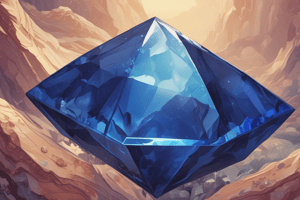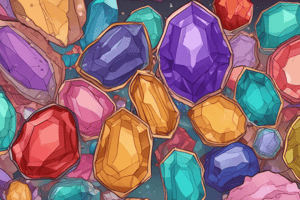Podcast
Questions and Answers
What type of treatment was used to create vivid red and green hues in pale andesine feldspar?
What type of treatment was used to create vivid red and green hues in pale andesine feldspar?
- Irradiation only
- Heat treatment only
- Copper-diffusion treatment (correct)
- Irradiation followed by heat treatment
What type of feldspar was treated through a heating process to diffuse copper into yellow andesine?
What type of feldspar was treated through a heating process to diffuse copper into yellow andesine?
- Labradorite
- Andesine (correct)
- Sunstone
- Kunzite
What type of material is often used to imitate sunstone?
What type of material is often used to imitate sunstone?
- Goldstone (correct)
- Glass
- Synthetic sapphire
- Synthetic spinel
What type of treatment was used to create kunzite's attractive rosy color?
What type of treatment was used to create kunzite's attractive rosy color?
Which type of feldspar is not treated and is a big selling point of the natural 'Oregon' sunstone?
Which type of feldspar is not treated and is a big selling point of the natural 'Oregon' sunstone?
What is the chemical composition of Feldspar?
What is the chemical composition of Feldspar?
Which type of Feldspar is known for its blue, silver, or white adularescent effect?
Which type of Feldspar is known for its blue, silver, or white adularescent effect?
What is the Mohs hardness of Chrome Diopside?
What is the Mohs hardness of Chrome Diopside?
Which type of Feldspar is known for its red-brown body color and sunny glitter?
Which type of Feldspar is known for its red-brown body color and sunny glitter?
What is the crystal structure of Amazonite?
What is the crystal structure of Amazonite?
Which type of Feldspar is known for its labradorescence?
Which type of Feldspar is known for its labradorescence?
What is the common cut for Moonstone?
What is the common cut for Moonstone?
Which type of Feldspar is known for its aventurescence?
Which type of Feldspar is known for its aventurescence?
What is the trade name for Oregon Sunstone?
What is the trade name for Oregon Sunstone?
What is the origin of the Andesine feldspar that was claimed to be from Congo, Tibet, and Inner Mongolia?
What is the origin of the Andesine feldspar that was claimed to be from Congo, Tibet, and Inner Mongolia?
What is the characteristic of goldstone that distinguishes it from sunstone?
What is the characteristic of goldstone that distinguishes it from sunstone?
What is the result of heating and diffusing copper into yellow andesine and labradorite feldspars?
What is the result of heating and diffusing copper into yellow andesine and labradorite feldspars?
What is the characteristic of kunzite that is achieved through heat treatment?
What is the characteristic of kunzite that is achieved through heat treatment?
What is a common imitation material for kunzite?
What is a common imitation material for kunzite?
Which feldspar type displays multicolored adularescence?
Which feldspar type displays multicolored adularescence?
What is the name of the phenomenon that causes a sparkly, metallic luster in sunstone?
What is the name of the phenomenon that causes a sparkly, metallic luster in sunstone?
What is the characteristic of parrot green moonstone that is not common in other moonstones?
What is the characteristic of parrot green moonstone that is not common in other moonstones?
What is the name of the feldspar type that is known for its vivid, intense pink and violetish purple colors?
What is the name of the feldspar type that is known for its vivid, intense pink and violetish purple colors?
Which feldspar type has a triclinic crystal system?
Which feldspar type has a triclinic crystal system?
What is the name of the feldspar type that is known for its dark green to black color with four- or six-rayed asterism?
What is the name of the feldspar type that is known for its dark green to black color with four- or six-rayed asterism?
What is the name of the phenomenon that causes a star-like effect in some feldspars?
What is the name of the phenomenon that causes a star-like effect in some feldspars?
Which feldspar type is known for its bright green body color with a floating adularescent effect?
Which feldspar type is known for its bright green body color with a floating adularescent effect?
What is the name of the feldspar type that is known for its transparent, medium-dark, vivid green color?
What is the name of the feldspar type that is known for its transparent, medium-dark, vivid green color?
Which feldspar type is known for its light green to greenish blues hues with a grid-like white streaks pattern and a faint sheen ?
Which feldspar type is known for its light green to greenish blues hues with a grid-like white streaks pattern and a faint sheen ?
What is the characteristic of sunstone that is achieved through an undisclosed treatment?
What is the characteristic of sunstone that is achieved through an undisclosed treatment?
What is the common imitation material for sunstone?
What is the common imitation material for sunstone?
What is the controversy surrounding Andesine feldspar?
What is the controversy surrounding Andesine feldspar?
What is the result of heating and diffusing copper into yellow andesine and labradorite feldspars?
What is the result of heating and diffusing copper into yellow andesine and labradorite feldspars?
What is the treatment process used to create kunzite's attractive rosy color?
What is the treatment process used to create kunzite's attractive rosy color?
What is the name of the material that is often used to imitate kunzite?
What is the name of the material that is often used to imitate kunzite?
Which mineral group does Spodumene belong to?
Which mineral group does Spodumene belong to?
Which of the following mineral groups does Amazonite belong to?
Which of the following mineral groups does Amazonite belong to?
What is the mineral group that Chrome Diopside belongs to?
What is the mineral group that Chrome Diopside belongs to?
Which mineral group does Moonstone belong to?
Which mineral group does Moonstone belong to?
Which of the following mineral groups does Labradorite belong to?
Which of the following mineral groups does Labradorite belong to?
What is the mineral group that Sunstone belongs to?
What is the mineral group that Sunstone belongs to?
Which mineral group does Kunzite belong to?
Which mineral group does Kunzite belong to?
Which of the following mineral groups does Diopside belong to?
Which of the following mineral groups does Diopside belong to?
What is the mineral group that includes both Moonstone and Labradorite?
What is the mineral group that includes both Moonstone and Labradorite?
Which of the following mineral groups includes both Spodumene and Chrome Diopside?
Which of the following mineral groups includes both Spodumene and Chrome Diopside?
Flashcards are hidden until you start studying
Study Notes
Feldspar, Spodumene, and Diopside
Largest Consumers
- Moonstone: popular in Europe and the US in the early 1900s
- Sunstone: popular in China, and among upscale jewelry designers, collectors, and gem carvers in the US
- Kunzite: popular in the US and Japan among collectors and designers
Mohs Scale
- Moonstone: soft, 6 to 6.5
- Labradorite: fairly soft, 6, cleaves easily
- Amazonite: 6, with 2 cleavage directions
- Spodumene: 6.5 to 7, with cleavage in 2 directions
- Chrome Diopside: toughness is poor, hardness ranges from 5.5 to 6, with 2 cleavage directions
Variety/Species/Group
- Feldspar Group: includes Moonstone, Sunstone, and Amazonite
- Pyroxene Group: includes Spodumene and Diopside
- Spodumene: three varieties - hiddenite, triphane, and kunzite
Color/Hue Range/Value
- Moonstone: ranges from semitransparent to opaque, with colors including blue, silver, white, green, yellow, brown, and gray
- Labradorite: dark gray body color with spectral colors of blues and greens
- Sunstone: yellow, orange, or brown body color, with aventurescence
- Amazonite: white, light orange, or pink, with grid-like white streaks and faint sheen
- Kunzite: light pink to intense pink and violetish purple
- Chrome Diopside: transparent, medium-dark, vivid green
Chemical Composition
- Feldspar: contains aluminum, oxygen, and silicon, with potassium, calcium, and sodium as major components
- Moonstone: composed of two feldspar species, orthoclase and albite
- Labradorite: plagioclase feldspar, with fine, microscopic, intergrown layers of albite and other plagioclase
- Sunstone: orthoclase sunstone, with monoclinic crystal system
- Amazonite: microcline feldspar, with potassium-rich alkali feldspar series
- Chrome Diopside: contains trace elements chromium or vanadium
Possible Phenomena
- Moonstone: adularescence, chatoyancy, and four-rayed asterism
- Labradorite: labradorescence
- Sunstone: aventurescence, sparkly, metallic luster
- Chrome Diopside: four- or six-rayed asterism, or chatoyancy against a dark green to black background
Clarity Characteristic
- Moonstone: two cleavage directions, tiny tension cracks called centipedes
- Sunstone: inclusions can be hematite, copper, or other minerals
- Kunzite: cleavage in 2 directions, color tends to fade with exposure to bright light or high heat
Common Cuts
- Moonstone: cabochon, beads, carvings, and calibrated stones
- Labradorite: pendants, carved and polished objects, and tile
- Chrome Diopside: cut with shallow pavilions to avoid darkness
Countries of Origin
-
Moonstone: Sri Lanka, Southern India, Myanmar, and India
-
Labradorite: Finland, Madagascar
-
Sunstone: US (Oregon)
-
Amazonite: Brazil, India, Madagascar, Norway, Russia, and the US
-
Kunzite: Afghanistan, Brazil, Madagascar, and the US (California)
-
Chrome Diopside: eastern Siberia and Russia### Feldspar Group
-
Includes Moonstone, Sunstone, and Amazonite
-
Moonstone:
- Range from semitransparent to opaque, with blue, silver, or white adularescent effect
- Bodycolors vary widely from green, yellow, to brown, or gray to nearly black
- Finest are colorless, semitransparent, with a vivid blue adularescence
- Rainbow Moonstone: displays multicolored adularescence
- Parrot Green Moonstone: bright green body color, adularescence floats in this sea of green
-
Sunstone:
- Yellow, orange, or brown bodycolor, not all sunstones are aventurescent
- Appearance of phenomenon depends on the size of the inclusions
- Small inclusions create a reddish or golden sheen on top of any body color
- Larger inclusions create attractive, glittery reflections
- Oregon Sunstone: range includes colorless, pale yellow, pink, orange, red, green, and blue-green with copper inclusions
-
Amazonite:
- White, light orange, or pink, known as amazonite or Amazon stone in its light green to greenish blue hues
- Grid-like white streaks and faint sheen
Pyroxene Group
- Includes Spodumene & Diopside
- Kunzite:
- Light pink is most common, but top kunzite colors are intense pink and intense violetish purple
- Cleavage in 2 directions, color tends to fade with exposure to bright light or high heat
- Chrome Diopside:
- Transparent, medium-dark, vivid green, very little eye-visible inclusions
- Can occur with four- or six-rayed asterism or chatoyancy against a dark green to black background
Treatments and Imitations
- Sunstone: not treated, a big selling point of the natural "Oregon" sunstone
- Kunzite: irradiation followed by heat treatment can create kunzite's attractive rosy color from colorless or light-colored spodumene
- Sunstone: imitation material is a manmade glass called goldstone, often brownish orange with translucent, small, flat copper inclusions
- Kunzite: imitations include glass, synthetic sapphire, and synthetic spinel
Market and History
- Moonstone: popular in both Europe and the United States in the early 1900s
- Sunstone: consumers in China show a strong interest, current market is a specialized one, consisting of upscale jewelry designers, collectors, and gem carvers, as well as tourists to the Oregon desert seeking a precious all-American souvenir
- Kunzite: collectors' stone status in the US and Japan, periods of strong supply, it's popular w/designer and mass-market jewelry styles
- Controversy around Andesine: claimed to be from Congo, Tibet, and Inner Mongolia was actually all from a single unknown source, and that was actually treated through a heating process diffusing copper into yellow andesine and labradorite feldspars
Studying That Suits You
Use AI to generate personalized quizzes and flashcards to suit your learning preferences.




